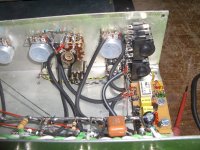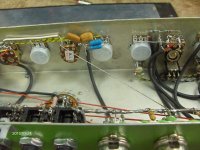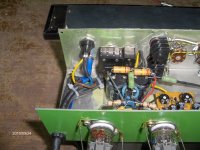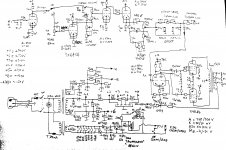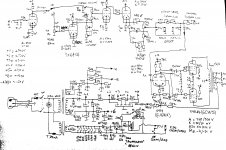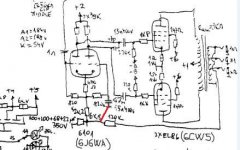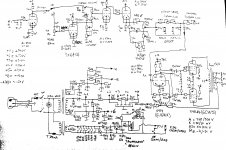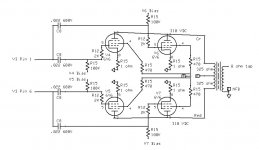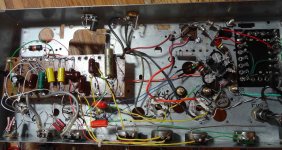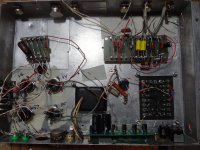Faceplate was created with "Card Maker 2.0("Zweckform"-program), and printed with HP-DJ970Cxi (ink-jet) on common office paper (80gr.). Glue was transparent spray lacquer on chassis first, than on paper for protect color and printing.
Did it take many attempts to get the spacing right? I have the worst luck with printers and scale drawings.
Did it take many attempts to get the spacing right? I have the worst luck with printers and scale drawings.
I have no problems with spacing when I start with "Card Maker 2.0" program.
With some other programs I have problems with spacing, colour and contrast.
Limit is my printer with A4 maximum dimension (297x210mm), and I am planing to bay another with A3 maximum dimension of paper (420x297mm).
Great looking amp and looks really well built! Do you have any sound clips of it working? It's just that the pre-amp uses valves different from the ubiquitous commercial use of ECC81 and ECC81s and I'm interested to hear the results
Sorry, no sound clips! My friend wish to keep amp for himself!
Attachments
EL86 PP guitar amp
This is just the thing I am looking for.
Do you have a higher resolution schematic you could post?
Very interesting! Fixed bias with individual adjustment pots. nice!
What is the PI tube?
I've got plenty of 6AV6s, and lots of premium Mullard/Amperex EL86s.
OT is 3K reflected load with 8 ohm speakers, and 25W?
This is just the thing I am looking for.
Do you have a higher resolution schematic you could post?
Very interesting! Fixed bias with individual adjustment pots. nice!
What is the PI tube?
I've got plenty of 6AV6s, and lots of premium Mullard/Amperex EL86s.
OT is 3K reflected load with 8 ohm speakers, and 25W?
This is just the thing I am looking for.
Do you have a higher resolution schematic you could post?
Very interesting! Fixed bias with individual adjustment pots. nice!
What is the PI tube?
I've got plenty of 6AV6s, and lots of premium Mullard/Amperex EL86s.
OT is 3K reflected load with 8 ohm speakers, and 25W?
-PI tube is 6101 or 6J6WA
-Raa is 3 kOhma. Pout is nominal 25W, but maximum output power is more than 30W.
Attachments
There is something wrong with drawing of the phase splitter, C missing ?
Mona
Wright! 47nF from grid tu ground! Sorry!
Isn't 340 (~300V) not a little bit to much for an EL86?.......EL86 work very well with Ua~340V (and more!) if screen voltage is low (<200V).
The 6CW5 and odd heater voltage twins will eat 350 volts on the plates if the screen is kept in the 170 to 200 volt range and 3K works too.
I have built a few amps using the 6CW5 on 340 volts with 170 volts on the screen and a 3300 ohm OPT. All have lived long lives without tube changes.
I made a "Marshall 18 Watt" clone for the Hundred Buck Amp Challenge. I am posting some of the details of the design in that thread. It ran UL84's on 340 volt and made about 30 watts at clip. The amp is somewhere in a box and hasn't been seen in over 2 years, since I moved everything 1200 miles....twice. It will be brought back to life once found.
Attachments
I recently built a lower voltage 6V6 Plexi. +325 B+ is what I could get out of my re-purposed Hewlett Packard PT. It sounds so good I'm now working on a Quad 6V6 Plexi with the same lower voltage PT. But with around that voltage, I've got another HP PT to use, it seems that 2 little EL86's will put out more output power than even the Quad 6V6!The 6CW5 and odd heater voltage twins will eat 350 volts on the plates if the screen is kept in the 170 to 200 volt range and 3K works too.
I have built a few amps using the 6CW5 on 340 volts with 170 volts on the screen and a 3300 ohm OPT. All have lived long lives without tube changes.
I made a "Marshall 18 Watt" clone for the Hundred Buck Amp Challenge. I am posting some of the details of the design in that thread. It ran UL84's on 340 volt and made about 30 watts at clip. The amp is somewhere in a box and hasn't been seen in over 2 years, since I moved everything 1200 miles....twice. It will be brought back to life once found.
I'm an Army trained repair tech, not an engineer/designer (yet). So I still need help modifying a design like the Plexi to use these EL86s as output tubes. If you guys wouldn't mind helping me do that I would be very grateful.
Attachments
I've got 18+ premium Mullard (Gt Brittan) Amperex (Holland) RCA (? GB/H???) to put to good use.
Here's a pic of the 1st Plexi's guts, and the mock up of the quad's guts.
I'm almost ready to wire the Quad up.
I hope to finish it before the end of the month.
I was going to do a different design build after that.
Now I think I want to stick with the Plexi, but an EL86 Plexi this time.
Here's a pic of the 1st Plexi's guts, and the mock up of the quad's guts.
I'm almost ready to wire the Quad up.
I hope to finish it before the end of the month.
I was going to do a different design build after that.
Now I think I want to stick with the Plexi, but an EL86 Plexi this time.
Attachments
Plexi EL86 PS mod
Since this EL86 has a strict requirement for it's screen V < 170 VDC a PS mod is necessary.
I was thinking that I could just keep my A-E nodes the same and add an F node for the screens. But then it occurred to me that these screens can and will pull more current than the 3 preamp tubes combined. An F node forces all that current to also run through the other nodes. I think this could cause some issues for my PS circuit.
For those of you that have used this tube with higher voltage preamp tube plate voltages, how did you solve this issue?
The HP PT I am using actually has 3 separate HV taps, so in theory I could actually run this screen voltage supply off a completely separate circuit if that is the best solution.
Any suggestions as to the best solution to use with my resources?
Since this EL86 has a strict requirement for it's screen V < 170 VDC a PS mod is necessary.
I was thinking that I could just keep my A-E nodes the same and add an F node for the screens. But then it occurred to me that these screens can and will pull more current than the 3 preamp tubes combined. An F node forces all that current to also run through the other nodes. I think this could cause some issues for my PS circuit.
For those of you that have used this tube with higher voltage preamp tube plate voltages, how did you solve this issue?
The HP PT I am using actually has 3 separate HV taps, so in theory I could actually run this screen voltage supply off a completely separate circuit if that is the best solution.
Any suggestions as to the best solution to use with my resources?
EL86 works very stable and long with screen voltage between 170V and 200V obtainable with divider resistors with the main high voltage supply, but such a method has caused quite a lot of permanent heating.
Voltage stabilizer with MOS-FET (IRF820) and several Zener diode provides required lower voltage with lower heating.
Voltage stabilizer with MOS-FET (IRF820) and several Zener diode provides required lower voltage with lower heating.
Two schools of thought here....
HiFi amp or clean guitar amp, run the screens from a stiff separate supply, derived from a separate winding, or a regulator off the plate supply. The regulator can be a simple mosfet and zener deal.
Guitar amp that will be overdriven....a lot. Many guitar players prefer an amp with "touch sensitivity" The threshold between "clean" and "cranked" is smooth and can be controlled by playing style or a gentle nudge of the guitar's volume knob. The screen current in the output stages of a guitar amp goes up dramatically as the output stage clips. This can be used to increase distortion and sustain in the preamp stages. How? Power the screens from a resistor off of main B+. Use a fat zener diode clamp to limit screen voltage during periods of low current draw (amp idle). With a 6CW5 running over 300 volts on the plates, try 180 to 200 volts. Power the entire preamp section, or one or two stages from the screen supply. This means running your preamp from a 180 - 200 volt supply, but it can be made to work. You want this supply to remain rather constant up to the point where the amp starts to distort. At this point you want it to "sag."
As the amp gets overdriven the screens draw enough current to drag the screen supply down, thus lowering the B+ to one or more preamp stages. This will lower their gain and increase their distortion. The effect increases as the guitar gets louder, causing a compression effect, and allowing the amps volume to remain relatively constant as the tone goes from clean to cranked. When the overload passes (the guitar player wants to sustain a continuous note, or backs off the volume) and the gain will slowly increase as the preamp B+ builds back up, increasing the sustain as the amp comes out of compression.
It sounds easy, but some serious tinkering with resistor and cap values throughout the preamp chain will be required to get it right. It took me a couple of weeks of tweaking on Amp 1.5 (a simple 4 tube amp in the HBAC thread) to get it right. I can go from clean to nasty just by flipping the pickup switch on a Strat, and get mild distortion in the clean mode by picking harder.
That amp only has 170 volts for the B+. The preamp runs from the screen supply and gets 160 V at idle and 120 V cranked. The first stage is a pentode that draws about 0.8 mA and the second stage is a single triode tube equal to half of a 12AX7. It works well on 160 volts drawing about 0.7 mA (tweak the cathode resistor to get about 90 to 100 volts on the plate, then tweak for best clean / cranked tone balance after everything else works.
HiFi amp or clean guitar amp, run the screens from a stiff separate supply, derived from a separate winding, or a regulator off the plate supply. The regulator can be a simple mosfet and zener deal.
Guitar amp that will be overdriven....a lot. Many guitar players prefer an amp with "touch sensitivity" The threshold between "clean" and "cranked" is smooth and can be controlled by playing style or a gentle nudge of the guitar's volume knob. The screen current in the output stages of a guitar amp goes up dramatically as the output stage clips. This can be used to increase distortion and sustain in the preamp stages. How? Power the screens from a resistor off of main B+. Use a fat zener diode clamp to limit screen voltage during periods of low current draw (amp idle). With a 6CW5 running over 300 volts on the plates, try 180 to 200 volts. Power the entire preamp section, or one or two stages from the screen supply. This means running your preamp from a 180 - 200 volt supply, but it can be made to work. You want this supply to remain rather constant up to the point where the amp starts to distort. At this point you want it to "sag."
As the amp gets overdriven the screens draw enough current to drag the screen supply down, thus lowering the B+ to one or more preamp stages. This will lower their gain and increase their distortion. The effect increases as the guitar gets louder, causing a compression effect, and allowing the amps volume to remain relatively constant as the tone goes from clean to cranked. When the overload passes (the guitar player wants to sustain a continuous note, or backs off the volume) and the gain will slowly increase as the preamp B+ builds back up, increasing the sustain as the amp comes out of compression.
It sounds easy, but some serious tinkering with resistor and cap values throughout the preamp chain will be required to get it right. It took me a couple of weeks of tweaking on Amp 1.5 (a simple 4 tube amp in the HBAC thread) to get it right. I can go from clean to nasty just by flipping the pickup switch on a Strat, and get mild distortion in the clean mode by picking harder.
That amp only has 170 volts for the B+. The preamp runs from the screen supply and gets 160 V at idle and 120 V cranked. The first stage is a pentode that draws about 0.8 mA and the second stage is a single triode tube equal to half of a 12AX7. It works well on 160 volts drawing about 0.7 mA (tweak the cathode resistor to get about 90 to 100 volts on the plate, then tweak for best clean / cranked tone balance after everything else works.
- Status
- This old topic is closed. If you want to reopen this topic, contact a moderator using the "Report Post" button.
- Home
- Live Sound
- Instruments and Amps
- 25W with 2xEL86(6CW5)!
